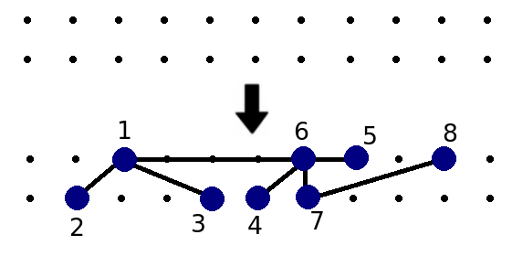这题要构造解
构造的解是这样的
首先我们把叶子节点以及相连的链标记is_lef
然后对每个点统计分出的链的次数(分出一颗大子树不计)
然后除链和Y形,点最多分出2个大子树,否则无解
#include<cstdio>
#include<cstring>
#include<cstdlib>
#include<algorithm>
#include<functional>
#include<iostream>
#include<cmath>
#include<cctype>
#include<ctime>
using namespace std;
#define For(i,n) for(int i=1;i<=n;i++)
#define Fork(i,k,n) for(int i=k;i<=n;i++)
#define Rep(i,n) for(int i=0;i<n;i++)
#define ForD(i,n) for(int i=n;i;i--)
#define RepD(i,n) for(int i=n;i>=0;i--)
#define Forp(x) for(int p=pre[x];p;p=next[p])
#define Forpiter(x) for(int &p=iter[x];p;p=next[p])
#define Lson (x<<1)
#define Rson ((x<<1)+1)
#define MEM(a) memset(a,0,sizeof(a));
#define MEMI(a) memset(a,127,sizeof(a));
#define MEMi(a) memset(a,128,sizeof(a));
#define INF (2139062143)
#define F (100000007)
#define MAXN (200000+10)
typedef long long ll;
ll mul(ll a,ll b){return (a*b)%F;}
ll add(ll a,ll b){return (a+b)%F;}
ll sub(ll a,ll b){return (a-b+(a-b)/F*F+F)%F;}
void upd(ll &a,ll b){a=(a%F+b%F)%F;}
int n;
int edge[MAXN],pre[MAXN],next[MAXN],siz=1;
void addedge(int u,int v) {
edge[++siz]=v;
next[siz]=pre[u];
pre[u]=siz;
}
void addedge2(int u,int v){addedge(u,v),addedge(v,u);}
int degree[MAXN]={0};
bool is_lef[MAXN]={0};
int legs[MAXN]={0};
void dfs(int x,int f)
{
is_lef[x]=1;
Forp(x) {
int v=edge[p];
if (v==f) continue;
if (degree[v]<=2) dfs(v,x); //链
}
}
int main()
{
// freopen("E.in","r",stdin);
// freopen(".out","w",stdout);
MEM(edge) MEM(pre) MEM(next)
cin>>n;
For(i,n-1) {
int u,v;
scanf("%d%d",&u,&v);
addedge2(u,v);
degree[u]++;degree[v]++;
}
//找链
For(i,n) {
if (degree[i]==1) dfs(i,0);
}
//找Y型
For(i,n) {
Forp(i) {
int v=edge[p];
if (is_lef[v]) ++legs[i]; //一个点连出的链数
}
}
bool flag=1;
For(i,n) {
if (is_lef[i]) continue;
int cnt=0;
Forp(i) {
int v=edge[p];
if (!is_lef[v]&°ree[v]-min(legs[v],2)>=2) //这个邻居不是链也不是Y
++cnt;
}
if (cnt>=3) { //只能向两边
flag=0;break;
}
}
if (flag) puts("Yes");
else puts("No");
return 0;
}
























 6万+
6万+

 被折叠的 条评论
为什么被折叠?
被折叠的 条评论
为什么被折叠?








